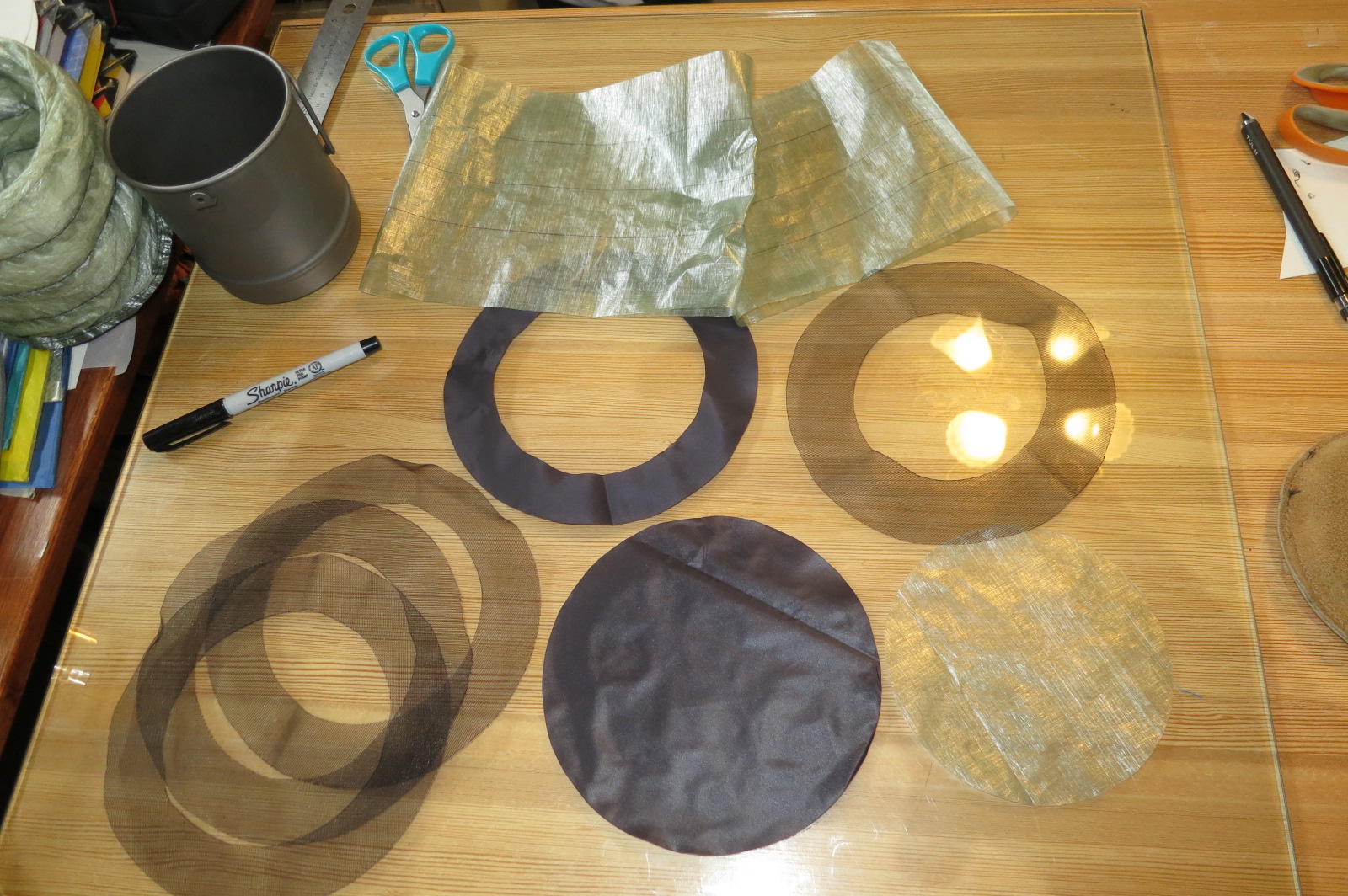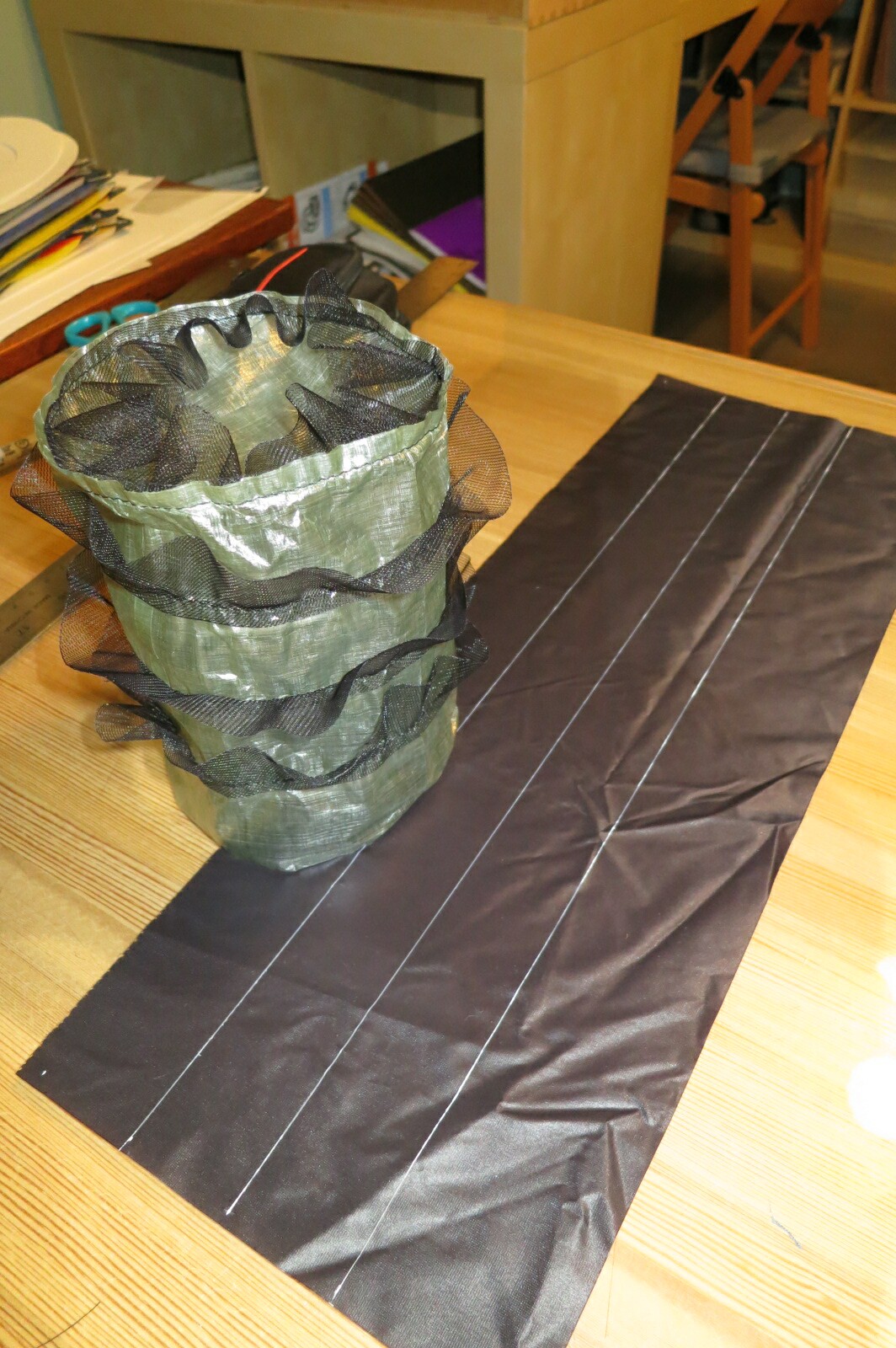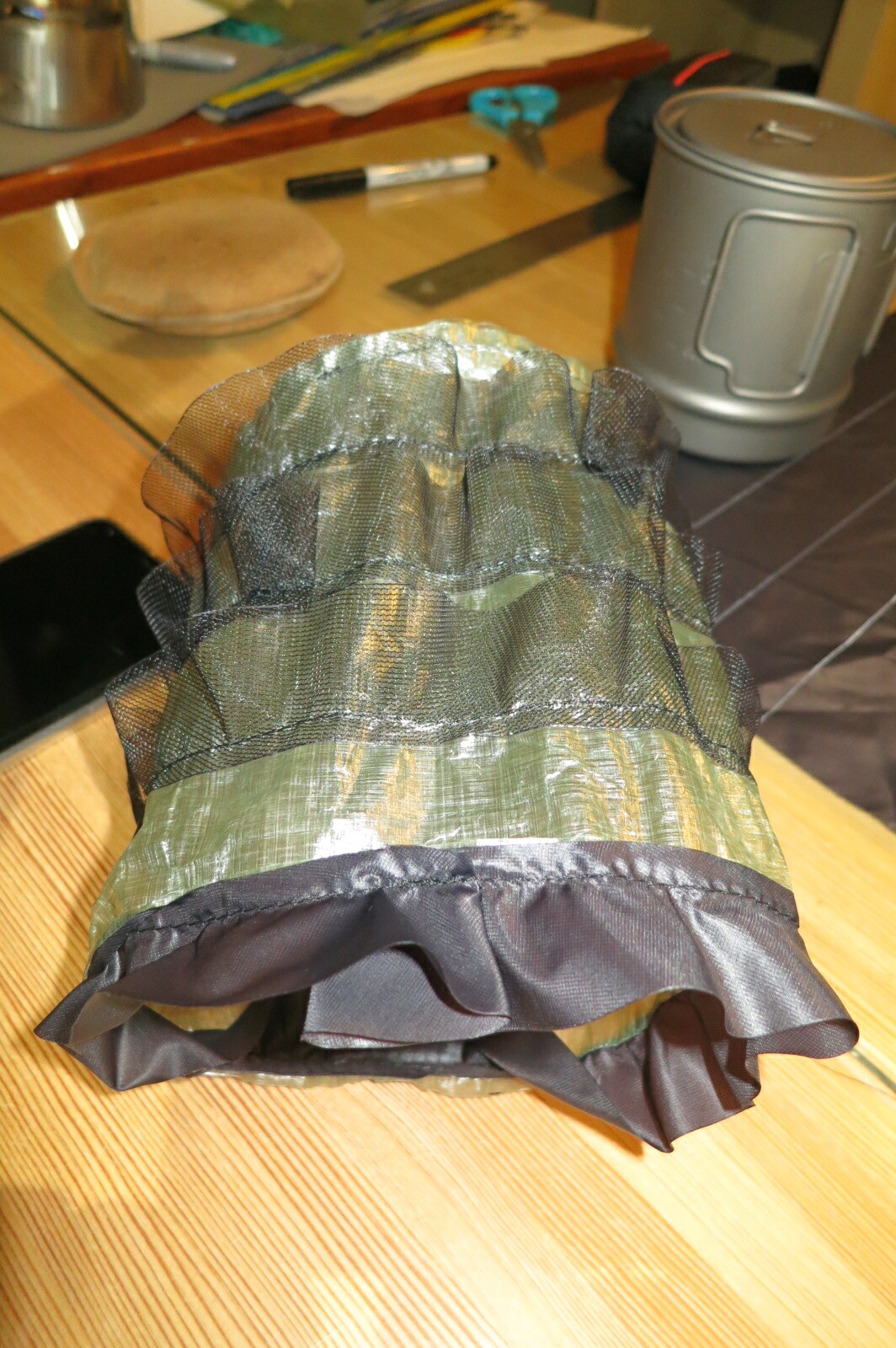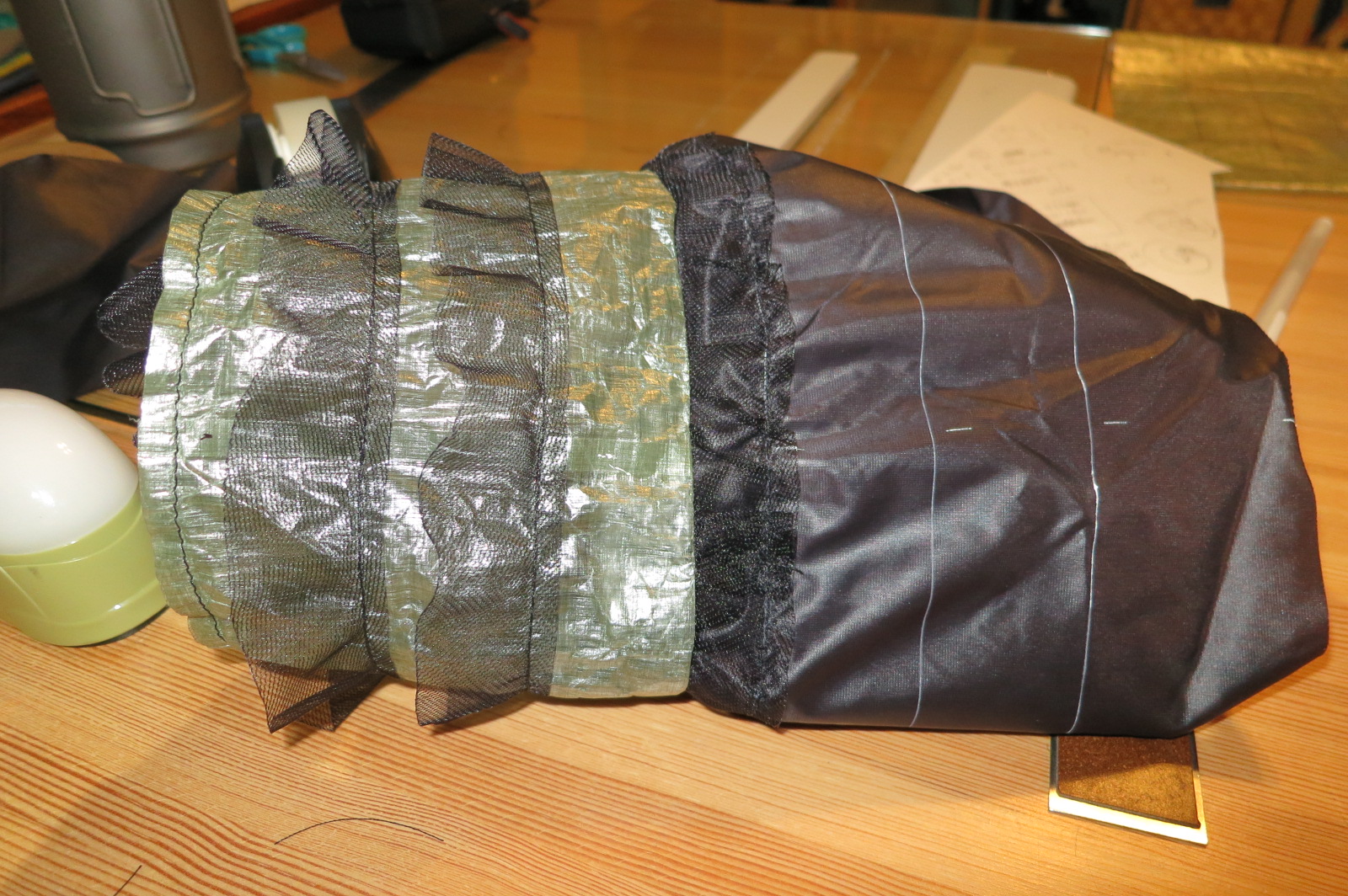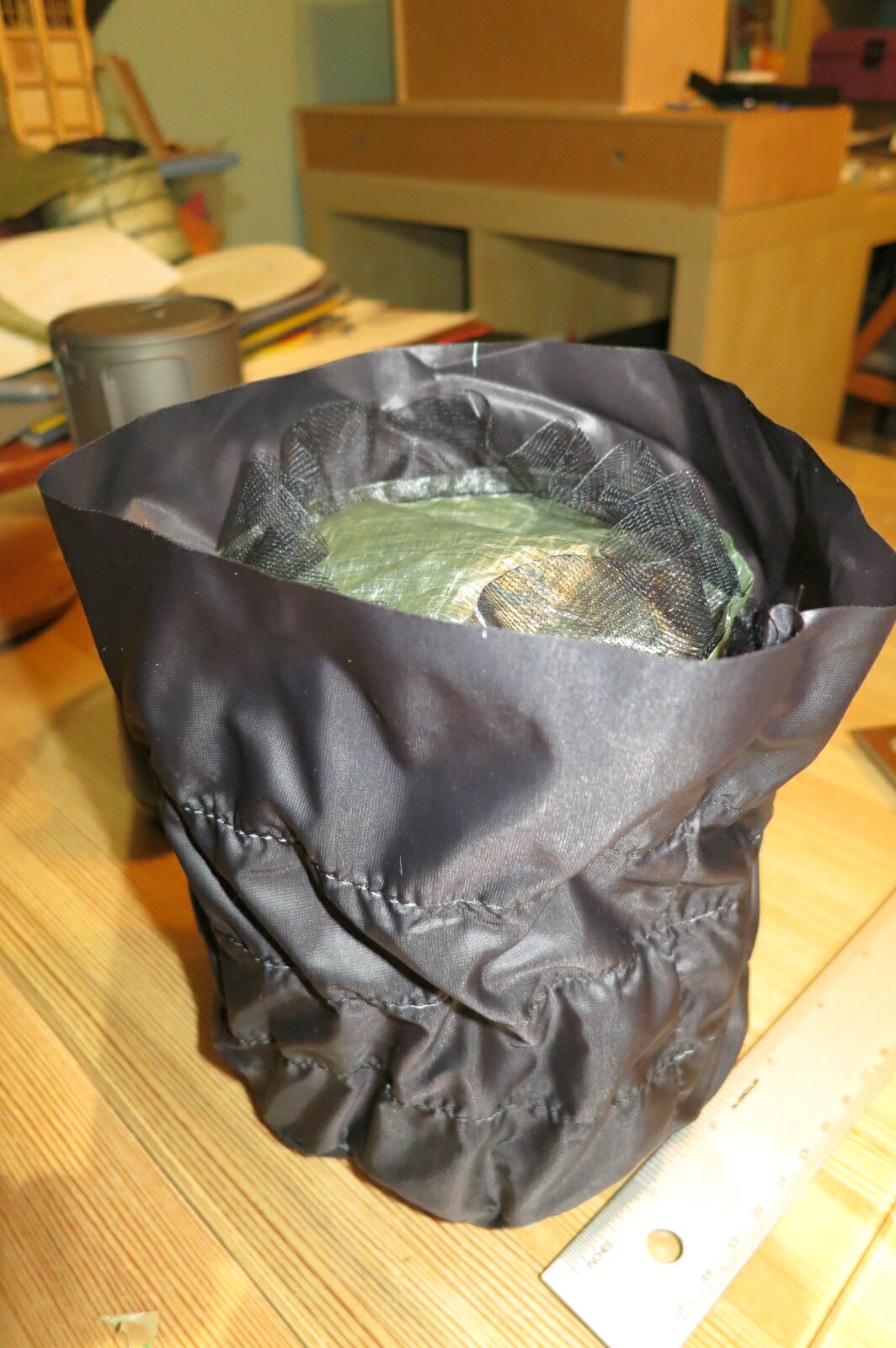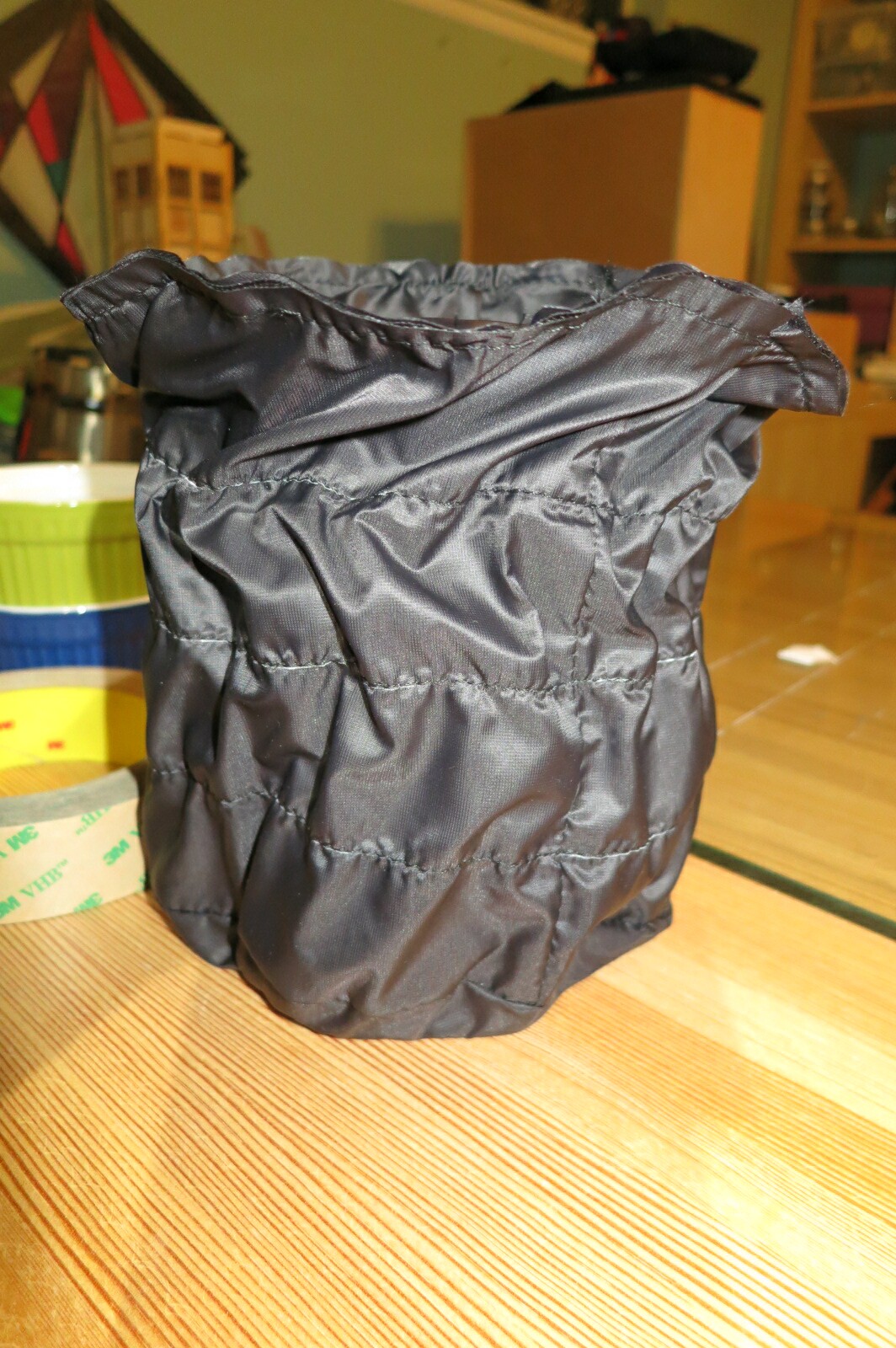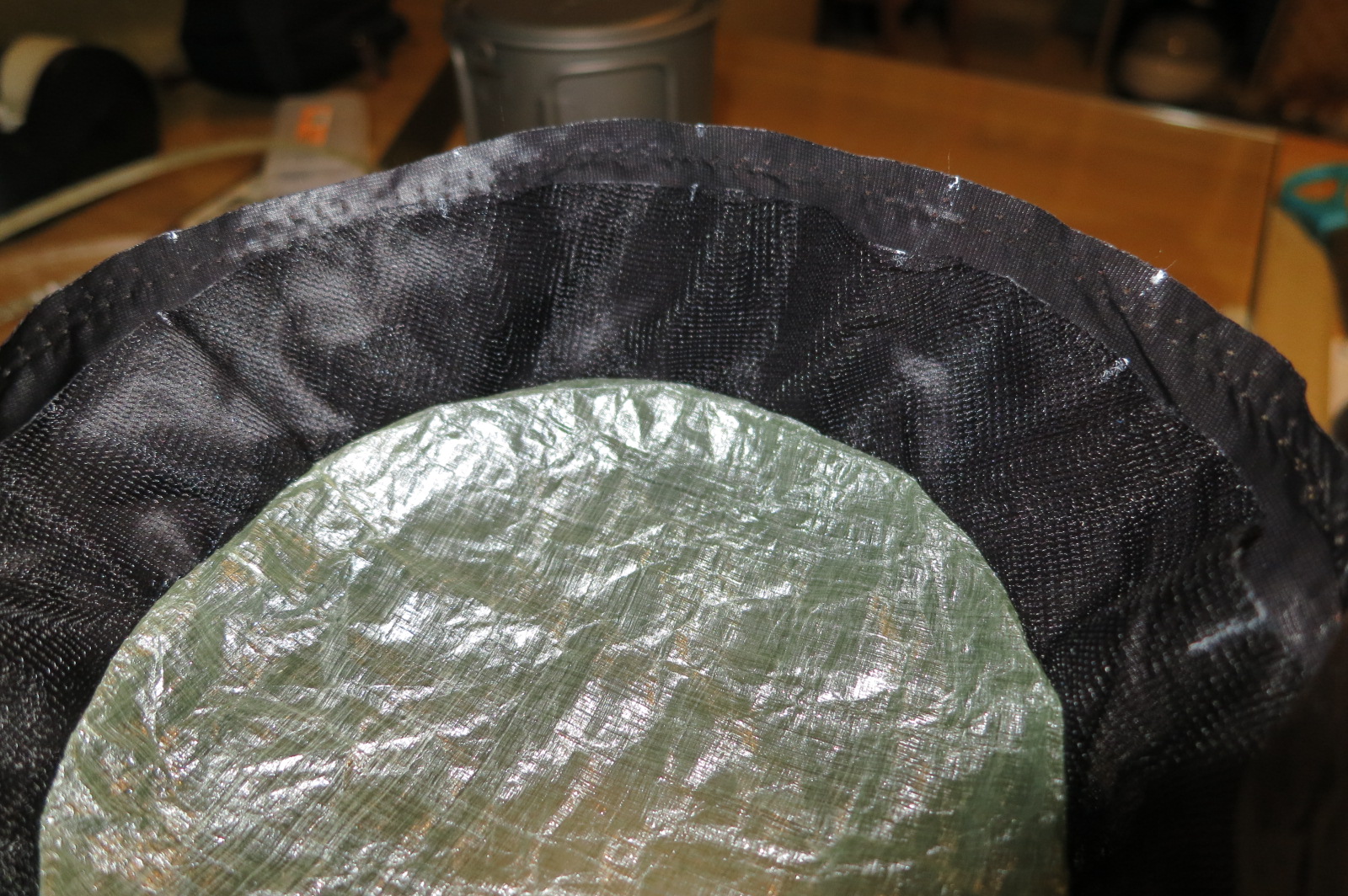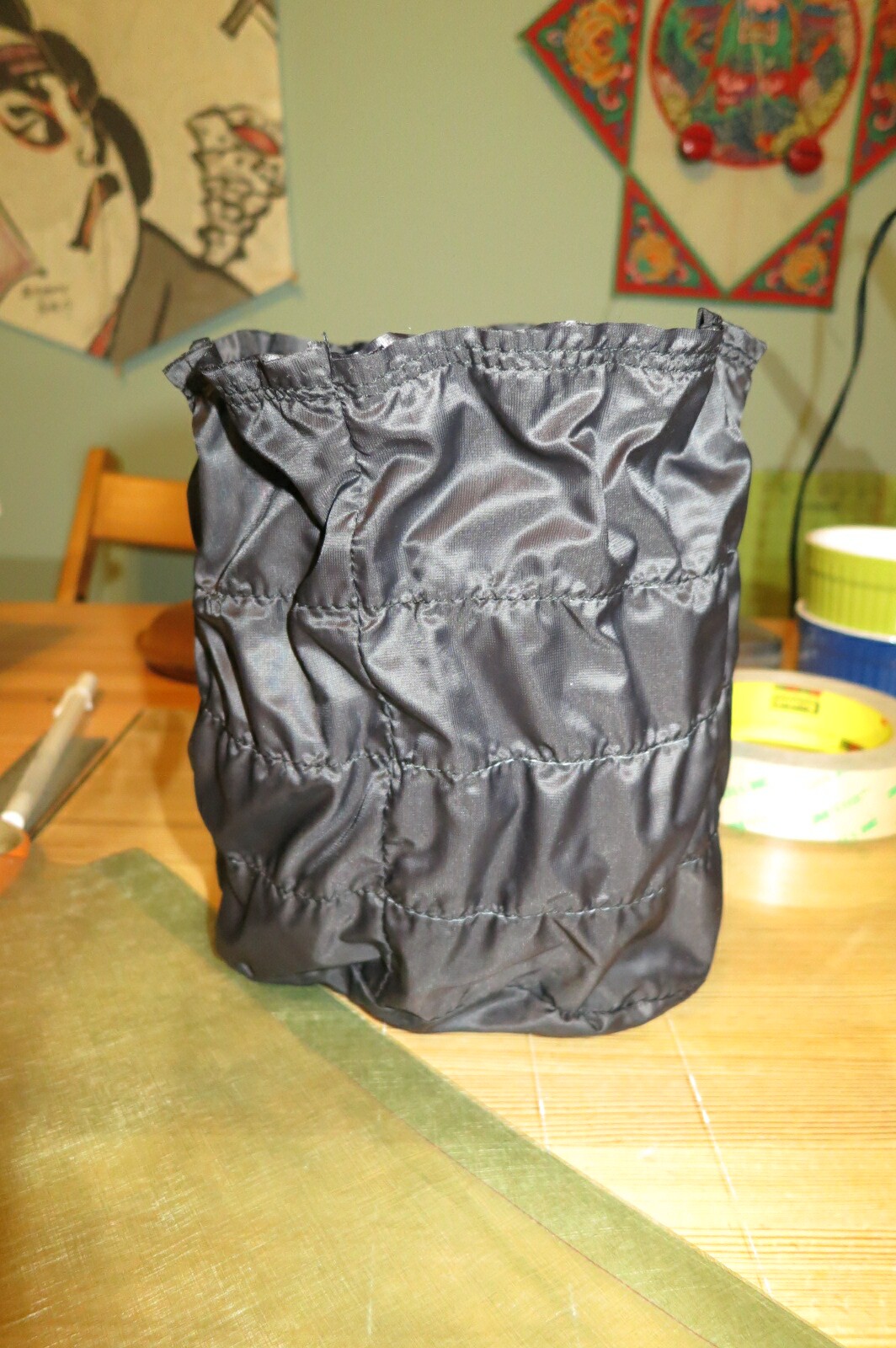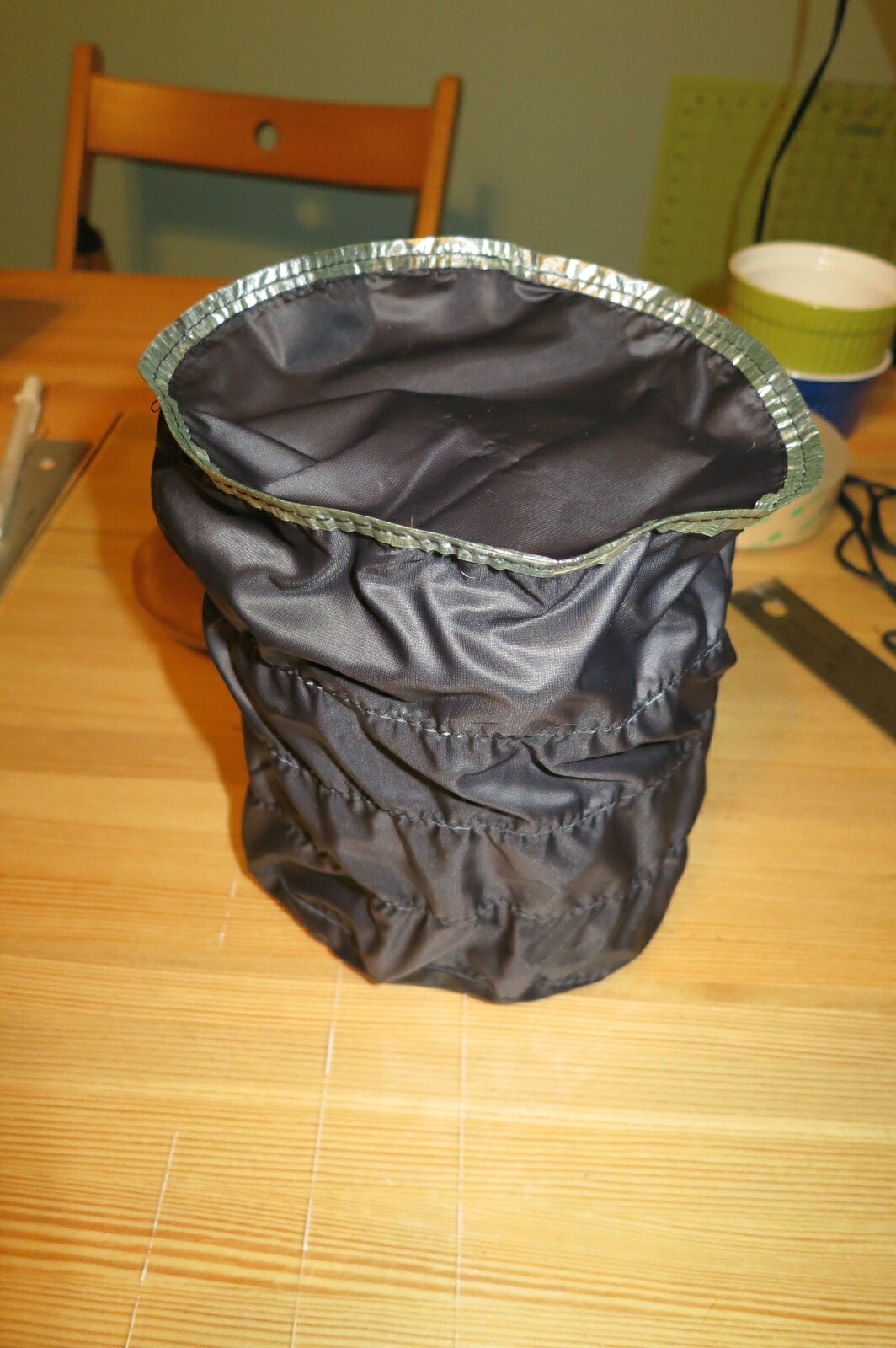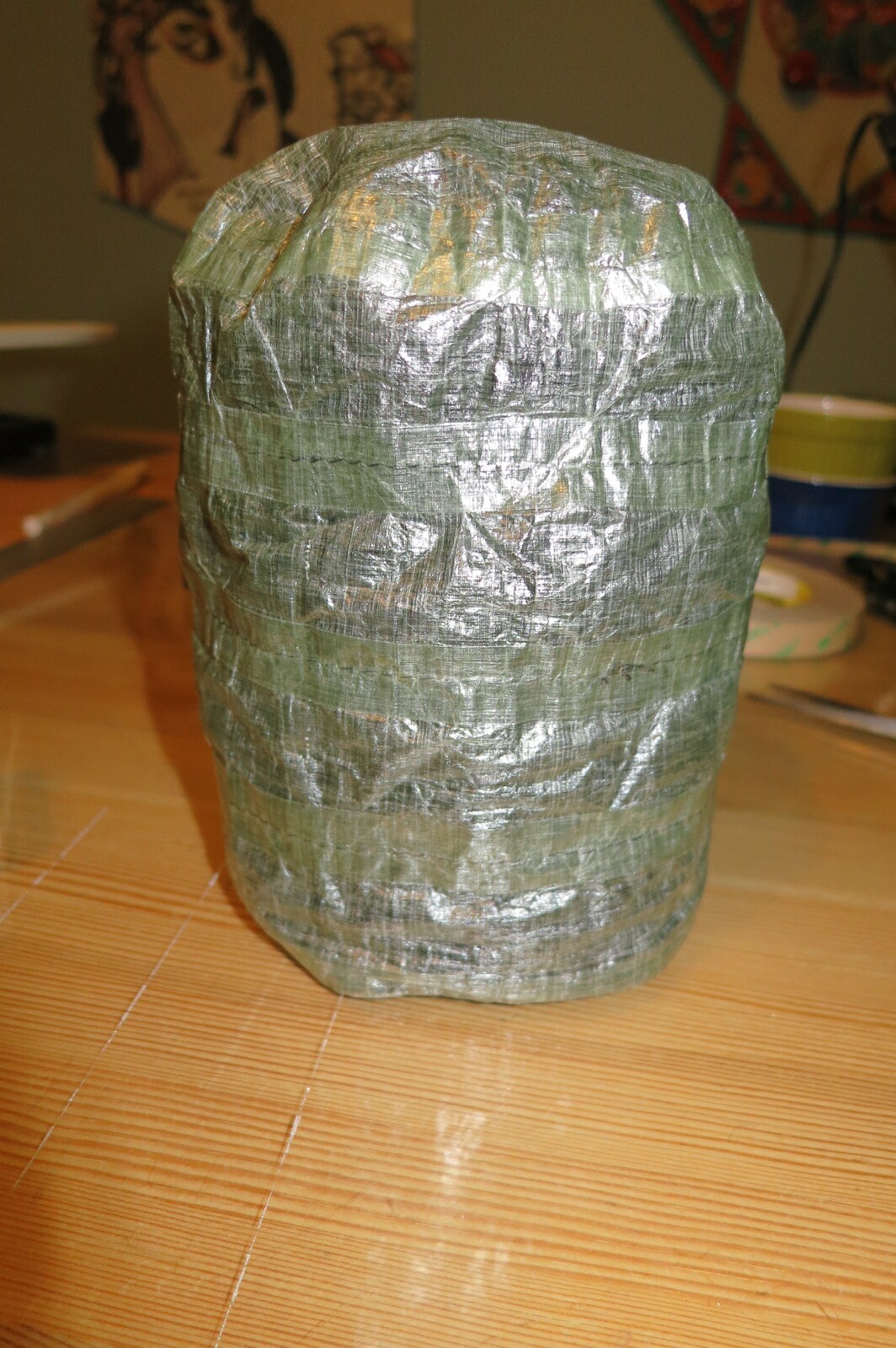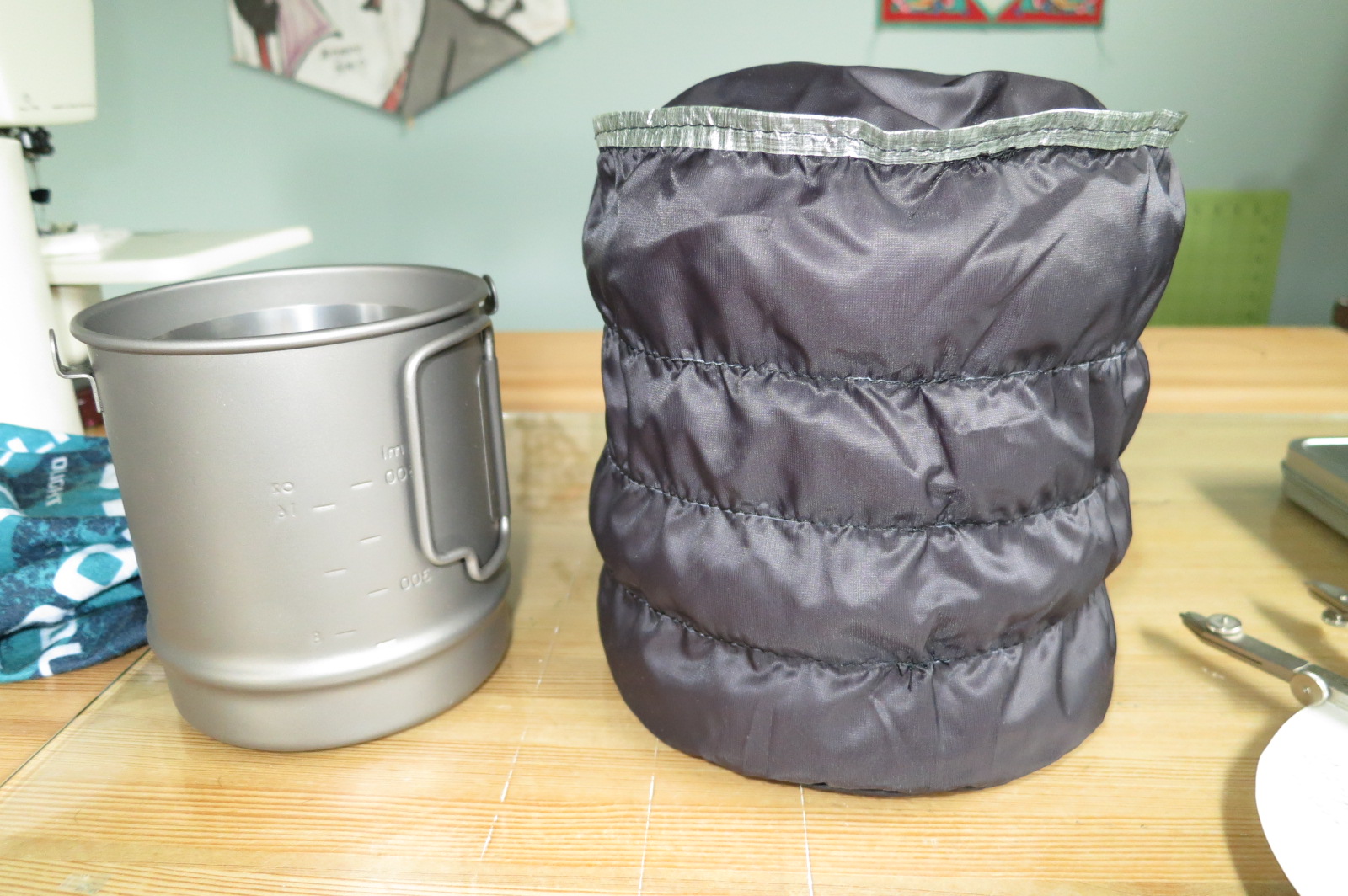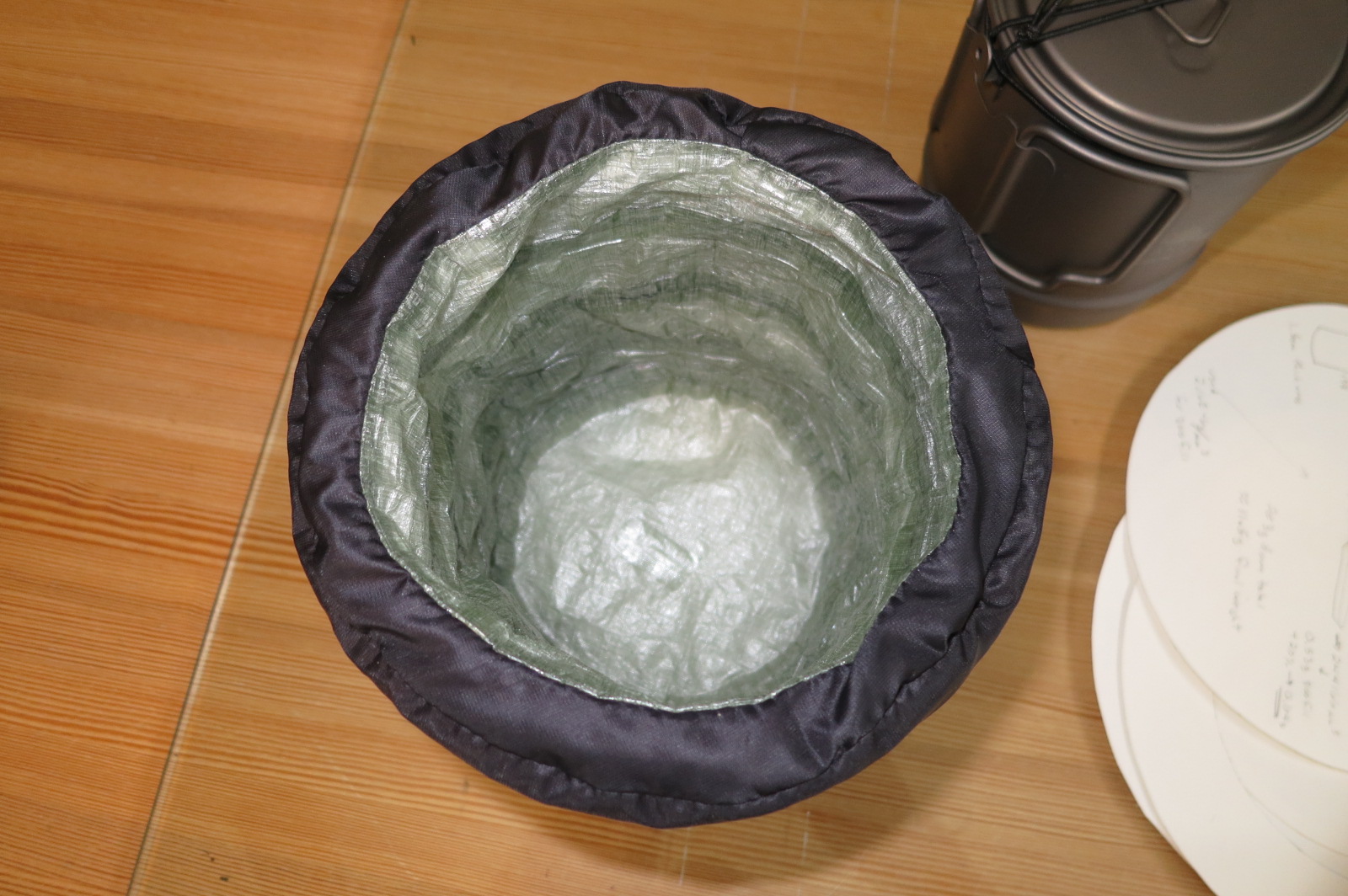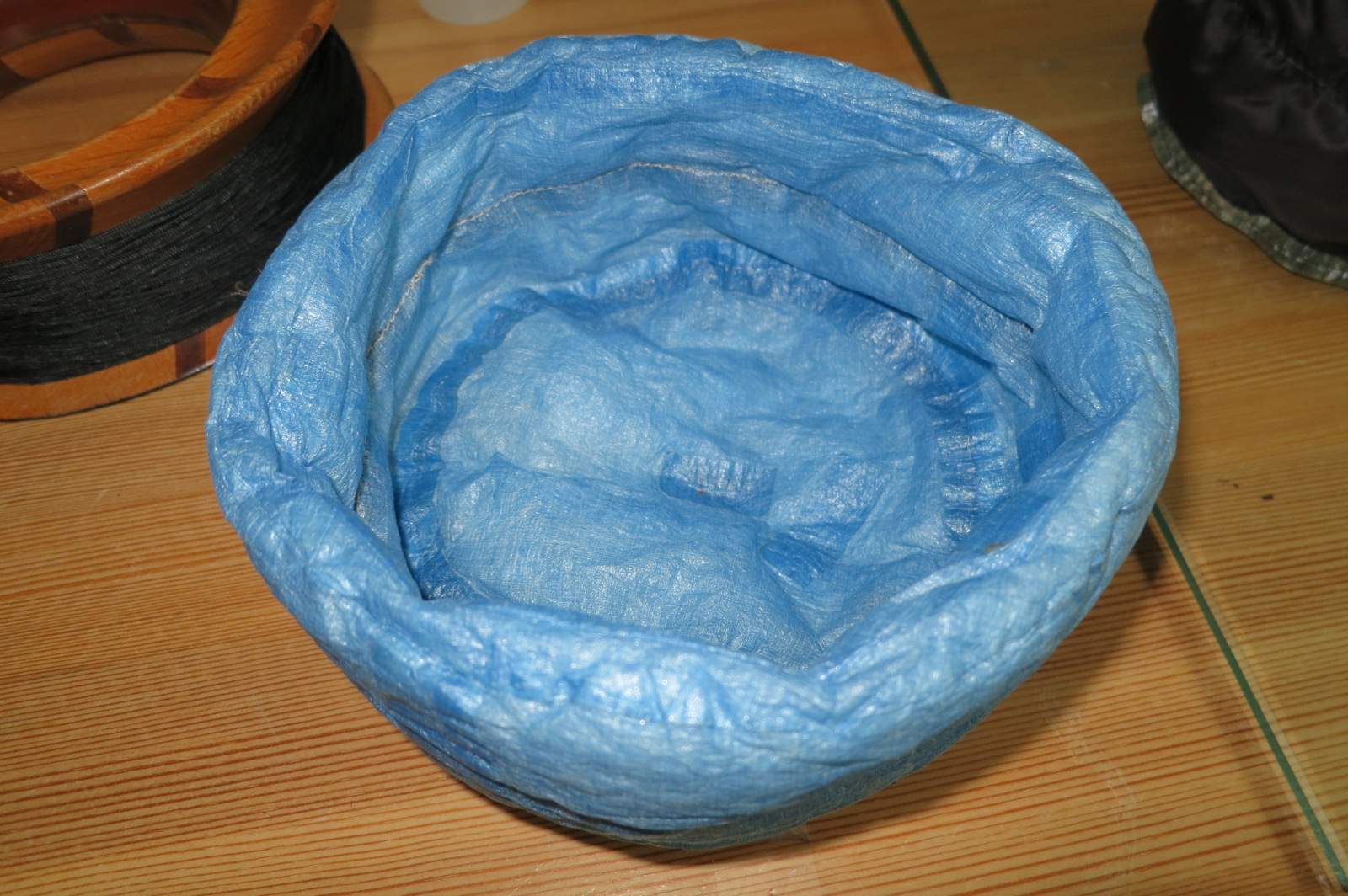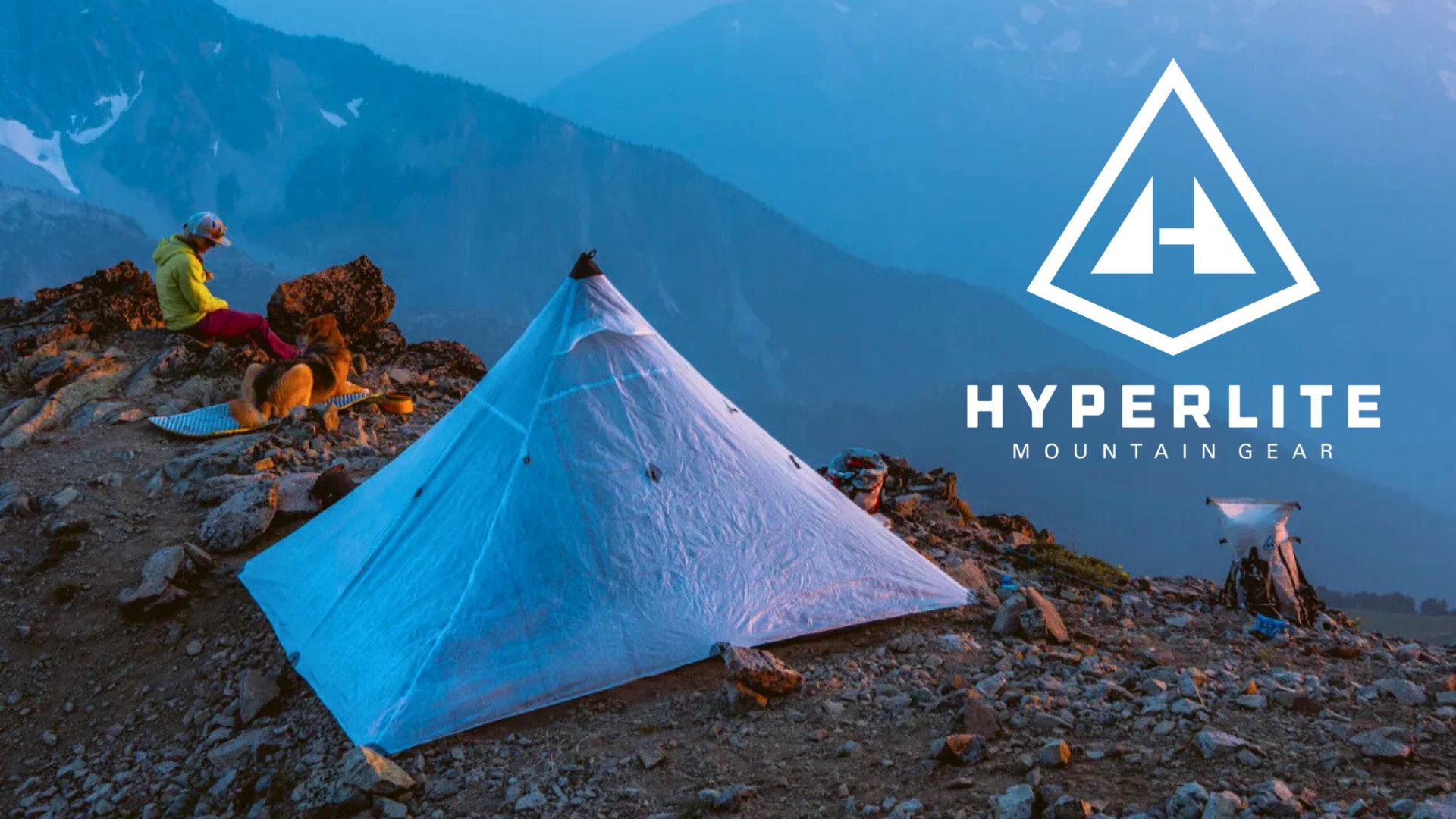Topic
Down Cozy
Forum Posting
A Membership is required to post in the forums. Login or become a member to post in the member forums!
Home › Forums › Gear Forums › Make Your Own Gear › Down Cozy
- This topic has 12 replies, 8 voices, and was last updated 5 years, 8 months ago by
 Mark Fowler.
Mark Fowler.
-
AuthorPosts
-
Mar 10, 2019 at 10:36 pm #3582786
Recently bought a 750ml Toaks pot from Zelph, with the ridge added (what a prize!). If down makes good insulation for humans, it certainly can make good insulation for my pot. A fully baffled, 1.5cm thick down cozy, with 0.5oz DCF on the inside and some downproof fabric (1.1oz Impetus) for the outside. Bug netting for the baffles. 1/4″ seam allowance
Most of the pieces:

Baffles sewn to inside first:

Bottom of cozy sewn on:

Outside sewn on, and marks placed on both the baffles and the outside surface so no twist is started off with:

Bottom three baffles went ok, but wait for the top one…

Two tries gave me this result for the top baffle. I was sewing through three layers (side, diagonal baffle, and top). I unstitched it a third time…

and ended up putting many marks to line up the sides with the baffle. The baffle was sewn first, then the top was sewn on.

Success.

DCF holds a fold very well, so it makes a good material to edge bind that last seam:

The inside seams were all taped up with DCF tape, 1/2″ wide, to prevent steam from getting to the down:

To stuff (as it was completely sewn up), I used a method I have used before (on another down cozy). A 1cm long slit was cut on the inside for a chamber, and the down was stuffed inside using tweezers (down taken off the bug net covered vacuum hose). Then the cut in the DCF is taped shut. 20% overstuff, but I might come back and put some more in. Total weight is 12g, with about 4g of that down.


Inside a stuff sack, this can be placed inside the pot to keep things from rattling. When in use, the pot sits on a 3/8″ thick disk of CCF to insulate it from the ground. This disk goes inside the pot as well.
Steve
Mar 10, 2019 at 11:51 pm #3582796How does DCF take to the heat ?
(from the hot pot)
Mar 11, 2019 at 12:01 am #3582799Just fine, no issues. My other cozy has many, many ‘miles’ on it. It has DCF on both the inside and the outside, and I can’t feel or see any difference.
 Mar 13, 2019 at 9:39 pm #3583340
Mar 13, 2019 at 9:39 pm #3583340Cool project! My first question is the one Franco asked, because DCF has such a low melting point.
My second question is whether you have run any tests for heat retention compared to a cozy made out of reflectix or CCF, for example bring a half liter to a roiling boil, place in cozy, then measure water temp after 15 minutes.
Mar 15, 2019 at 9:01 pm #3583743This weekend I’ll test my down cozy vs.a CCF cozy that I have made for my Evernew 600. I did a qualitative test between CCF and reflectix years ago and it was no comparison, the CCF was considerably warmer after a period of time.
Jun 2, 2019 at 6:29 pm #3595915Finally got around to getting a thermometer and comparing a down cozy with a CCF cozy. Summary; about even performance, comparing a 1/4″ CCF (1/2″ thick lid) with a 1-2cm thick down cozy.
Same amount of water was heated in microwave for the same amount of time, water coming from tap. Starting water in 600mL titanium pot was at 197.2 (down cozy) and 196 (CCF cozy), temperature measured after 20 min, reached 172.9 (down cozy) and 172.6 (CCF cozy).
The newer down cozy I made for the Toaks is 50% thicker compared to what I used in this test. And it packs inside the pot, keeping stuff from rattling, where a CCF cozy is susceptible to wear and tear.
I don’t have any reflectix to make a cozy, but I’ve tested it before; much worse than a CCF cozy, going by the feel of the water. Makes sense, as large bubbles of air would allow convective heat loss (the reflective aspect is almost meaningless in this usage).
Jun 3, 2019 at 3:50 am #3595991Anonymous
InactiveNice project. I’ve written similar at different points in the past about using down (and down+foam) in a cozy.
Not sure why DCF though, unless you just had some extra left over that you didn’t need for any thing else?
Otherwise, I would use one of the Silpoly PU4000 fabrics from RSBR. Very, very highly waterproof and probably more vapor impermeable than many other fabrics out there, and much, much cheaper than DCF. You won’t save much noticeable weight by using DCF for such a small item.
Did you put an IR reflector in there? That would be helpful.
Jun 3, 2019 at 4:11 am #3595994Great project and testing! Thanks for posting this.
I did some tests a few years ago on ccf vs. reflectix and the comparison was sort of a joke – ccf was much more effective.
I made an apex (synthetic insulation) reflector and it can’t compete with my ccf one either (both are the same weight).
I think the main advantage of high loft insulation like down or apex is their much lower compressed bulk:weight ratio.
I made a crazy bivy sack many years ago made entirely of closed cell foam. It was surprisingly warm for its weight. But omg the packed size of this thing – think 4 ridgerest deluxes…!
Jun 3, 2019 at 4:45 am #3595997Anonymous
InactiveRyan, I think I remember reading Richard Nisley talking about how high quality Down, beat every other insulation on a weight to warmth basis–even including standard, silica aerogels.
The one exception to this might be expanding foam–I think that may have even a slightly better warmth to weight ratio than even high quality down?
But as you said, the compressibility is where it really shines in comparison.
Theoretically speaking, one could take two thinnish bamboo containers of slightly different size, reinforce them with epoxy/high strength fiber composite and thin, outer high density EVA foam (on the outside of the outer container), line the inner part of the inner container with food grade silicone, then pull a vacuum between them, and seal it up.
Getting a vacuum insulated “thermos” like container at much lighter weight than a SS one, or even a Ti one.
I would love to build such a thermos, but I don’t have the equipment to do so in an efficient and well working manner (nor am I sure about how you would seal it up, once the vacuum has been pulled).
Jun 3, 2019 at 2:01 pm #3596032Thanks for the feedback everyone.
DCF was used because 1) I had some extra 2) it is easy to work with 3) the seams can be taped easily to keep the moisture from the down.
Jun 3, 2019 at 11:50 pm #3596095I have never used a specific cozy, I just put my hat over it and my bandana over that. But this looks interesting…
Jun 4, 2019 at 11:56 pm #3596245Anyone have suggestions on the sweet spot of ccf thickness when used in a cozy?
Ryan – what thickness did you use when comparing to reflectix?
Jun 5, 2019 at 1:48 am #3596265I made cozies out of reflectix (windscreen shade material), insulbrite and 2 layers of 2-3mm blue closed cell foam glued together. The insulbrite was sewn between layers of silnylon while the ccf one was a close fit into a sil-nylon stuff sack. When tested they all performed very similarly – over 10 minutes the reflectix one (27g) dropped 5.5 deg C, the foam (14g) 5.1 deg and the insulbrite (15g) 6.6 deg.
The pot was an Evernew ECA-265 900ml with 500ml of water starting at 90 deg C and an air temperature of 23 deg C. The pot has a bail handle so there is no need for a split in the side of the cozy.
I have been using the ccf one now for a couple of years and it has stood up to the use although it does rely on the tight fit in the stuff sack for durability. It is not removed from the stuff sack for use.
-
AuthorPosts
- You must be logged in to reply to this topic.
Forum Posting
A Membership is required to post in the forums. Login or become a member to post in the member forums!
LAST CALL (Sale Ends Feb 24) - Hyperlite Mountain Gear's Biggest Sale of the Year.
All DCF shelters, packs, premium quilts, and accessories are on sale.
Our Community Posts are Moderated
Backpacking Light community posts are moderated and here to foster helpful and positive discussions about lightweight backpacking. Please be mindful of our values and boundaries and review our Community Guidelines prior to posting.
Get the Newsletter
Gear Research & Discovery Tools
- Browse our curated Gear Shop
- See the latest Gear Deals and Sales
- Our Recommendations
- Search for Gear on Sale with the Gear Finder
- Used Gear Swap
- Member Gear Reviews and BPL Gear Review Articles
- Browse by Gear Type or Brand.

